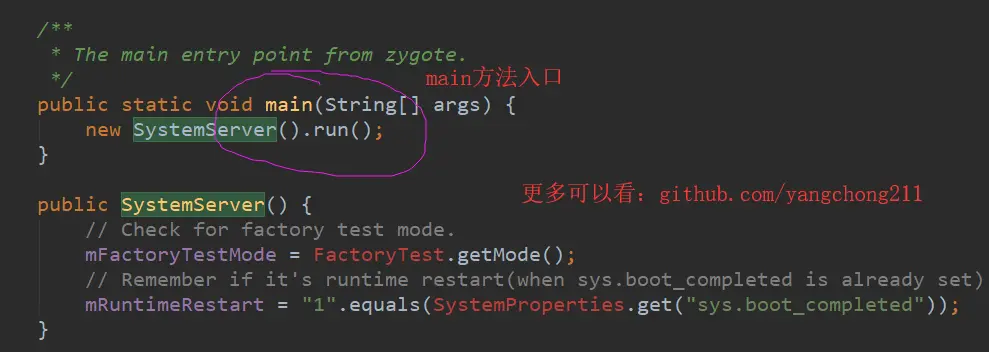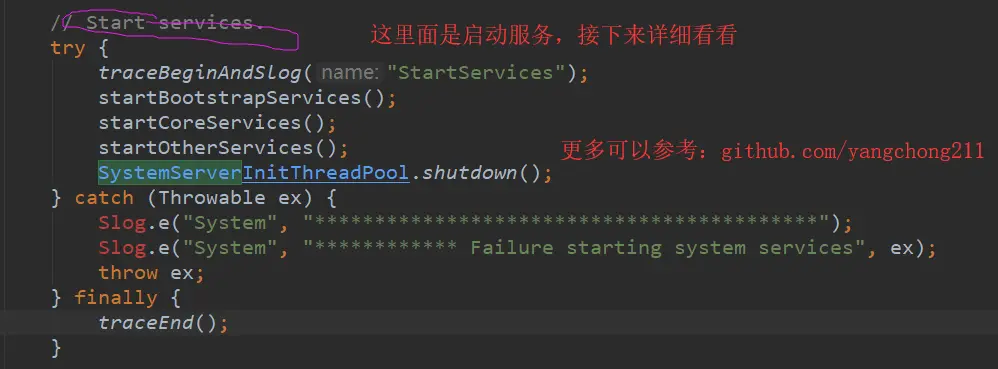Android App 启动流程
1.什么是Zygote进程
1.1 简单介绍
- Zygote进程是所有的android进程的父进程,包括SystemServer和各种应用进程都是通过Zygote进程fork出来的。Zygote(孵化)进程相当于是android系统的根进程,后面所有的进程都是通过这个进程fork出来的
- 虽然Zygote进程相当于Android系统的根进程,但是事实上它也是由Linux系统的init进程启动的。
1.2 各个进程的先后顺序
- init进程 –> Zygote进程 –> SystemServer进程 –>各种应用进程
1.3 进程作用说明
- init进程:linux的根进程,android系统是基于linux系统的,因此可以算作是整个android操作系统的第一个进程;
- Zygote进程:android系统的根进程,主要作用:可以作用Zygote进程fork出SystemServer进程和各种应用进程;
- SystemService进程:主要是在这个进程中启动系统的各项服务,比如ActivityManagerService,PackageManagerService,WindowManagerService服务等等;
- 各种应用进程:启动自己编写的客户端应用时,一般都是重新启动一个应用进程,有自己的虚拟机与运行环境;
2.Zygote进程的启动流程
2.1 源码位置
- 位置:frameworks/base/core/java/com/android/internal/os/ZygoteInit.java
- Zygote进程mian方法主要执行逻辑:
- 初始化DDMS;
- 注册Zygote进程的socket通讯;
- 初始化Zygote中的各种类,资源文件,OpenGL,类库,Text资源等等;
- 初始化完成之后fork出SystemServer进程;
- fork出SystemServer进程之后,关闭socket连接;
2.2 ZygoteInit类的main方法
init进程在启动Zygote进程时一般都会调用ZygoteInit类的main方法,因此这里看一下该方法的具体实现(基于android23源码);
- 调用enableDdms(),设置DDMS可用,可以发现DDMS启动的时机还是比较早的,在整个Zygote进程刚刚开始要启动额时候就设置可用。
- 之后初始化各种参数
- 通过调用registerZygoteSocket方法,注册为Zygote进程注册Socket
- 然后调用preload方法实现预加载各种资源
- 然后通过调用startSystemServer开启SystemServer服务,这个是重点
1
2
3
4
5
6
7
8
9
10
11
12
13
14
15
16
17
18
19
20
21
22
23
24
25
26
27
28
29
30
31
32
33
34
35
36
37
38
39
40
41
42
43
44
45
46
47
48
49
50
51public static void main(String argv[]) {
try {
//设置ddms可以用
RuntimeInit.enableDdms();
SamplingProfilerIntegration.start();
boolean startSystemServer = false;
String socketName = "zygote";
String abiList = null;
for (int i = 1; i < argv.length; i++) {
if ("start-system-server".equals(argv[i])) {
startSystemServer = true;
} else if (argv[i].startsWith(ABI_LIST_ARG)) {
abiList = argv[i].substring(ABI_LIST_ARG.length());
} else if (argv[i].startsWith(SOCKET_NAME_ARG)) {
socketName = argv[i].substring(SOCKET_NAME_ARG.length());
} else {
throw new RuntimeException("Unknown command line argument: " + argv[i]);
}
}
if (abiList == null) {
throw new RuntimeException("No ABI list supplied.");
}
registerZygoteSocket(socketName);
EventLog.writeEvent(LOG_BOOT_PROGRESS_PRELOAD_START,
SystemClock.uptimeMillis());
preload();
EventLog.writeEvent(LOG_BOOT_PROGRESS_PRELOAD_END,
SystemClock.uptimeMillis());
SamplingProfilerIntegration.writeZygoteSnapshot();
gcAndFinalize();
Trace.setTracingEnabled(false);
if (startSystemServer) {
startSystemServer(abiList, socketName);
}
Log.i(TAG, "Accepting command socket connections");
runSelectLoop(abiList);
closeServerSocket();
} catch (MethodAndArgsCaller caller) {
caller.run();
} catch (RuntimeException ex) {
Log.e(TAG, "Zygote died with exception", ex);
closeServerSocket();
throw ex;
}
}
2.3 registerZygoteSocket(socketName)分析
调用registerZygoteSocket(String socketName)为Zygote进程注册socket
1
2
3
4
5
6
7
8
9
10
11
12
13
14
15
16
17
18
19
20
21private static void registerZygoteSocket(String socketName) {
if (sServerSocket == null) {
int fileDesc;
final String fullSocketName = ANDROID_SOCKET_PREFIX + socketName;
try {
String env = System.getenv(fullSocketName);
fileDesc = Integer.parseInt(env);
} catch (RuntimeException ex) {
throw new RuntimeException(fullSocketName + " unset or invalid", ex);
}
try {
FileDescriptor fd = new FileDescriptor();
fd.setInt$(fileDesc);
sServerSocket = new LocalServerSocket(fd);
} catch (IOException ex) {
throw new RuntimeException(
"Error binding to local socket '" + fileDesc + "'", ex);
}
}
}
2.4 preLoad()方法分析
源码如下所示
1
2
3
4
5
6
7
8
9
10
11
12static void preload() {
Log.d(TAG, "begin preload");
preloadClasses();
preloadResources();
preloadOpenGL();
preloadSharedLibraries();
preloadTextResources();
// Ask the WebViewFactory to do any initialization that must run in the zygote process,
// for memory sharing purposes.
WebViewFactory.prepareWebViewInZygote();
Log.d(TAG, "end preload");
}大概操作是这样的:
- preloadClasses()用于初始化Zygote中需要的class类;
- preloadResources()用于初始化系统资源;
- preloadOpenGL()用于初始化OpenGL;
- preloadSharedLibraries()用于初始化系统libraries;
- preloadTextResources()用于初始化文字资源;
- prepareWebViewInZygote()用于初始化webview;
2.5 startSystemServer()启动进程
这段逻辑的执行逻辑就是通过Zygote fork出SystemServer进程
1
2
3
4
5
6
7
8
9
10
11
12
13
14
15
16
17
18
19
20
21
22
23
24
25
26
27
28
29
30
31
32
33
34
35
36
37
38
39
40
41
42
43
44
45
46
47
48
49
50
51
52
53
54
55
56
57private static boolean startSystemServer(String abiList, String socketName)
throws MethodAndArgsCaller, RuntimeException {
long capabilities = posixCapabilitiesAsBits(
OsConstants.CAP_BLOCK_SUSPEND,
OsConstants.CAP_KILL,
OsConstants.CAP_NET_ADMIN,
OsConstants.CAP_NET_BIND_SERVICE,
OsConstants.CAP_NET_BROADCAST,
OsConstants.CAP_NET_RAW,
OsConstants.CAP_SYS_MODULE,
OsConstants.CAP_SYS_NICE,
OsConstants.CAP_SYS_RESOURCE,
OsConstants.CAP_SYS_TIME,
OsConstants.CAP_SYS_TTY_CONFIG
);
/* Hardcoded command line to start the system server */
String args[] = {
"--setuid=1000",
"--setgid=1000",
"--setgroups=1001,1002,1003,1004,1005,1006,1007,1008,1009,1010,1018,1021,1032,3001,3002,3003,3006,3007",
"--capabilities=" + capabilities + "," + capabilities,
"--nice-name=system_server",
"--runtime-args",
"com.android.server.SystemServer",
};
ZygoteConnection.Arguments parsedArgs = null;
int pid;
try {
parsedArgs = new ZygoteConnection.Arguments(args);
ZygoteConnection.applyDebuggerSystemProperty(parsedArgs);
ZygoteConnection.applyInvokeWithSystemProperty(parsedArgs);
/* Request to fork the system server process */
pid = Zygote.forkSystemServer(
parsedArgs.uid, parsedArgs.gid,
parsedArgs.gids,
parsedArgs.debugFlags,
null,
parsedArgs.permittedCapabilities,
parsedArgs.effectiveCapabilities);
} catch (IllegalArgumentException ex) {
throw new RuntimeException(ex);
}
/* For child process */
if (pid == 0) {
if (hasSecondZygote(abiList)) {
waitForSecondaryZygote(socketName);
}
handleSystemServerProcess(parsedArgs);
}
return true;
}
3.SystemServer进程启动流程
3.1 SystemServer进程简介
- SystemServer进程主要的作用是在这个进程中启动各种系统服务,比如ActivityManagerService,PackageManagerService,WindowManagerService服务,以及各种系统性的服务其实都是在SystemServer进程中启动的,而当我们的应用需要使用各种系统服务的时候其实也是通过与SystemServer进程通讯获取各种服务对象的句柄的。
3.2 SystemServer的main方法
- 如下所示,比较简单,只是new出一个SystemServer对象并执行其run方法,查看SystemServer类的定义我们知道其实final类型的,所以我们一般不能重写或者继承。

3.3 查看run方法
代码如下所示
- 首先判断系统当前时间,若当前时间小于1970年1月1日,则一些初始化操作可能会处所,所以当系统的当前时间小于1970年1月1日的时候,设置系统当前时间为该时间点。
- 然后是设置系统的语言环境等
- 接着设置虚拟机运行内存,加载运行库,设置SystemServer的异步消息
1
2
3
4
5
6
7
8
9
10
11
12
13
14
15
16
17
18
19
20
21
22
23
24
25
26
27
28
29
30
31
32
33
34
35
36
37
38
39
40
41
42
43
44
45
46
47
48
49
50
51
52
53
54
55
56
57
58
59
60
61
62
63
64
65
66
67
68
69
70
71
72
73
74
75
76
77
78
79
80
81
82
83
84
85
86
87
88
89private void run() {
if (System.currentTimeMillis() < EARLIEST_SUPPORTED_TIME) {
Slog.w(TAG, "System clock is before 1970; setting to 1970.");
SystemClock.setCurrentTimeMillis(EARLIEST_SUPPORTED_TIME);
}
if (!SystemProperties.get("persist.sys.language").isEmpty()) {
final String languageTag = Locale.getDefault().toLanguageTag();
SystemProperties.set("persist.sys.locale", languageTag);
SystemProperties.set("persist.sys.language", "");
SystemProperties.set("persist.sys.country", "");
SystemProperties.set("persist.sys.localevar", "");
}
Slog.i(TAG, "Entered the Android system server!");
EventLog.writeEvent(EventLogTags.BOOT_PROGRESS_SYSTEM_RUN, SystemClock.uptimeMillis());
SystemProperties.set("persist.sys.dalvik.vm.lib.2", VMRuntime.getRuntime().vmLibrary());
if (SamplingProfilerIntegration.isEnabled()) {
SamplingProfilerIntegration.start();
mProfilerSnapshotTimer = new Timer();
mProfilerSnapshotTimer.schedule(new TimerTask() {
@Override
public void run() {
SamplingProfilerIntegration.writeSnapshot("system_server", null);
}
}, SNAPSHOT_INTERVAL, SNAPSHOT_INTERVAL);
}
// Mmmmmm... more memory!
VMRuntime.getRuntime().clearGrowthLimit();
// The system server has to run all of the time, so it needs to be
// as efficient as possible with its memory usage.
VMRuntime.getRuntime().setTargetHeapUtilization(0.8f);
// Some devices rely on runtime fingerprint generation, so make sure
// we've defined it before booting further.
Build.ensureFingerprintProperty();
// Within the system server, it is an error to access Environment paths without
// explicitly specifying a user.
Environment.setUserRequired(true);
// Ensure binder calls into the system always run at foreground priority.
BinderInternal.disableBackgroundScheduling(true);
// Prepare the main looper thread (this thread).
android.os.Process.setThreadPriority(
android.os.Process.THREAD_PRIORITY_FOREGROUND);
android.os.Process.setCanSelfBackground(false);
Looper.prepareMainLooper();
// Initialize native services.
System.loadLibrary("android_servers");
// Check whether we failed to shut down last time we tried.
// This call may not return.
performPendingShutdown();
// Initialize the system context.
createSystemContext();
// Create the system service manager.
mSystemServiceManager = new SystemServiceManager(mSystemContext);
LocalServices.addService(SystemServiceManager.class, mSystemServiceManager);
// Start services.
try {
startBootstrapServices();
startCoreServices();
startOtherServices();
} catch (Throwable ex) {
Slog.e("System", "******************************************");
Slog.e("System", "************ Failure starting system services", ex);
throw ex;
}
// For debug builds, log event loop stalls to dropbox for analysis.
if (StrictMode.conditionallyEnableDebugLogging()) {
Slog.i(TAG, "Enabled StrictMode for system server main thread.");
}
// Loop forever.
Looper.loop();
throw new RuntimeException("Main thread loop unexpectedly exited");
}然后下面的代码是:
1
2
3
4
5
6
7
8
9
10
11
12
13
14
15
16
17// Initialize the system context.
createSystemContext();
// Create the system service manager.
mSystemServiceManager = new SystemServiceManager(mSystemContext);
LocalServices.addService(SystemServiceManager.class, mSystemServiceManager);
// Start services.
try {
startBootstrapServices();
startCoreServices();
startOtherServices();
} catch (Throwable ex) {
Slog.e("System", "******************************************");
Slog.e("System", "************ Failure starting system services", ex);
throw ex;
}
3.4 run方法中createSystemContext()解析
调用createSystemContext()方法:
- 可以看到在SystemServer进程中也存在着Context对象,并且是通过ActivityThread.systemMain方法创建context的,这一部分的逻辑以后会通过介绍Activity的启动流程来介绍,这里就不在扩展,只知道在SystemServer进程中也需要创建Context对象。
1
2
3
4
5private void createSystemContext() {
ActivityThread activityThread = ActivityThread.systemMain();
mSystemContext = activityThread.getSystemContext();
mSystemContext.setTheme(android.R.style.Theme_DeviceDefault_Light_DarkActionBar);
}
3.5 mSystemServiceManager的创建
看run方法中,通过SystemServiceManager的构造方法创建了一个新的SystemServiceManager对象,我们知道SystemServer进程主要是用来构建系统各种service服务的,而SystemServiceManager就是这些服务的管理对象。
然后调用:
- 将SystemServiceManager对象保存SystemServer进程中的一个数据结构中。
1
LocalServices.addService(SystemServiceManager.class, mSystemServiceManager);
最后开始执行:
1
2
3
4
5
6
7
8
9
10// Start services.
try {
startBootstrapServices();
startCoreServices();
startOtherServices();
} catch (Throwable ex) {
Slog.e("System", "******************************************");
Slog.e("System", "************ Failure starting system services", ex);
throw ex;
}- 里面主要涉及了是三个方法:
- startBootstrapServices() 主要用于启动系统Boot级服务
- startCoreServices() 主要用于启动系统核心的服务
- startOtherServices() 主要用于启动一些非紧要或者是非需要及时启动的服务
- 里面主要涉及了是三个方法:
4.启动服务
4.1 启动哪些服务
- 在开始执行启动服务之前总是会先尝试通过socket方式连接Zygote进程,在成功连接之后才会开始启动其他服务。

4.2 启动服务流程源码分析
首先看一下startBootstrapServices方法:
1
2
3
4
5
6
7
8
9
10
11
12
13
14
15
16
17
18
19
20
21
22
23
24
25
26
27
28
29
30
31
32
33
34
35
36
37
38
39
40
41
42
43
44
45
46
47
48
49
50
51
52private void startBootstrapServices() {
Installer installer = mSystemServiceManager.startService(Installer.class);
mActivityManagerService = mSystemServiceManager.startService(
ActivityManagerService.Lifecycle.class).getService();
mActivityManagerService.setSystemServiceManager(mSystemServiceManager);
mActivityManagerService.setInstaller(installer);
mPowerManagerService = mSystemServiceManager.startService(PowerManagerService.class);
mActivityManagerService.initPowerManagement();
// Manages LEDs and display backlight so we need it to bring up the display.
mSystemServiceManager.startService(LightsService.class);
// Display manager is needed to provide display metrics before package manager
// starts up.
mDisplayManagerService = mSystemServiceManager.startService(DisplayManagerService.class);
// We need the default display before we can initialize the package manager.
mSystemServiceManager.startBootPhase(SystemService.PHASE_WAIT_FOR_DEFAULT_DISPLAY);
// Only run "core" apps if we're encrypting the device.
String cryptState = SystemProperties.get("vold.decrypt");
if (ENCRYPTING_STATE.equals(cryptState)) {
Slog.w(TAG, "Detected encryption in progress - only parsing core apps");
mOnlyCore = true;
} else if (ENCRYPTED_STATE.equals(cryptState)) {
Slog.w(TAG, "Device encrypted - only parsing core apps");
mOnlyCore = true;
}
// Start the package manager.
Slog.i(TAG, "Package Manager");
mPackageManagerService = PackageManagerService.main(mSystemContext, installer,
mFactoryTestMode != FactoryTest.FACTORY_TEST_OFF, mOnlyCore);
mFirstBoot = mPackageManagerService.isFirstBoot();
mPackageManager = mSystemContext.getPackageManager();
Slog.i(TAG, "User Service");
ServiceManager.addService(Context.USER_SERVICE, UserManagerService.getInstance());
// Initialize attribute cache used to cache resources from packages.
AttributeCache.init(mSystemContext);
// Set up the Application instance for the system process and get started.
mActivityManagerService.setSystemProcess();
// The sensor service needs access to package manager service, app ops
// service, and permissions service, therefore we start it after them.
startSensorService();
}先执行:
1
Installer installer = mSystemServiceManager.startService(Installer.class);
mSystemServiceManager是系统服务管理对象,在main方法中已经创建完成,这里我们看一下其startService方法的具体实现:
- 可以看到通过反射器构造方法创建出服务类,然后添加到SystemServiceManager的服务列表数据中,最后调用了service.onStart()方法,因为传递的是Installer.class
1
2
3
4
5
6
7
8
9
10
11
12
13
14
15
16
17
18
19
20
21
22
23
24
25
26
27
28
29
30
31
32
33
34
35
36
37
38
39public <T extends SystemService> T startService(Class<T> serviceClass) {
final String name = serviceClass.getName();
Slog.i(TAG, "Starting " + name);
// Create the service.
if (!SystemService.class.isAssignableFrom(serviceClass)) {
throw new RuntimeException("Failed to create " + name
+ ": service must extend " + SystemService.class.getName());
}
final T service;
try {
Constructor<T> constructor = serviceClass.getConstructor(Context.class);
service = constructor.newInstance(mContext);
} catch (InstantiationException ex) {
throw new RuntimeException("Failed to create service " + name
+ ": service could not be instantiated", ex);
} catch (IllegalAccessException ex) {
throw new RuntimeException("Failed to create service " + name
+ ": service must have a public constructor with a Context argument", ex);
} catch (NoSuchMethodException ex) {
throw new RuntimeException("Failed to create service " + name
+ ": service must have a public constructor with a Context argument", ex);
} catch (InvocationTargetException ex) {
throw new RuntimeException("Failed to create service " + name
+ ": service constructor threw an exception", ex);
}
// Register it.
mServices.add(service);
// Start it.
try {
service.onStart();
} catch (RuntimeException ex) {
throw new RuntimeException("Failed to start service " + name
+ ": onStart threw an exception", ex);
}
return service;
}看一下Installer的onStart方法:
- 很简单就是执行了mInstaller的waitForConnection方法,这里简单介绍一下Installer类,该类是系统安装apk时的一个服务类,继承SystemService(系统服务的一个抽象接口),需要在启动完成Installer服务之后才能启动其他的系统服务。
1
2
3
4
5@Override
public void onStart() {
Slog.i(TAG, "Waiting for installd to be ready.");
mInstaller.waitForConnection();
}然后查看waitForConnection()方法:
- 通过追踪代码可以发现,其在不断的通过ping命令连接Zygote进程(SystemServer和Zygote进程通过socket方式通讯,其他进程通过Binder方式通讯)
1
2
3
4
5
6
7
8
9public void waitForConnection() {
for (;;) {
if (execute("ping") >= 0) {
return;
}
Slog.w(TAG, "installd not ready");
SystemClock.sleep(1000);
}
}继续看startBootstrapServices方法:
- 这段代码主要是用于启动ActivityManagerService服务,并为其设置SysServiceManager和Installer。ActivityManagerService是系统中一个非常重要的服务,Activity,service,Broadcast,contentProvider都需要通过其余系统交互。
1
2
3
4
5// Activity manager runs the show.
mActivityManagerService = mSystemServiceManager.startService(
ActivityManagerService.Lifecycle.class).getService();
mActivityManagerService.setSystemServiceManager(mSystemServiceManager);
mActivityManagerService.setInstaller(installer);首先看一下Lifecycle类的定义:
- 可以看到其实ActivityManagerService的一个静态内部类,在其构造方法中会创建一个ActivityManagerService,通过刚刚对Installer服务的分析我们知道,SystemServiceManager的startService方法会调用服务的onStart()方法,而在Lifecycle类的定义中我们看到其onStart()方法直接调用了mService.start()方法,mService是Lifecycle类中对ActivityManagerService的引用
1
2
3
4
5
6
7
8
9
10
11
12
13
14
15
16
17public static final class Lifecycle extends SystemService {
private final ActivityManagerService mService;
public Lifecycle(Context context) {
super(context);
mService = new ActivityManagerService(context);
}
@Override
public void onStart() {
mService.start();
}
public ActivityManagerService getService() {
return mService;
}
}
4.3 启动部分服务
启动PowerManagerService服务:
- 启动方式跟上面的ActivityManagerService服务相似都会调用其构造方法和onStart方法,PowerManagerService主要用于计算系统中和Power相关的计算,然后决策系统应该如何反应。同时协调Power如何与系统其它模块的交互,比如没有用户活动时,屏幕变暗等等。
1
mPowerManagerService = mSystemServiceManager.startService(PowerManagerService.class);
然后是启动LightsService服务
- 主要是手机中关于闪光灯,LED等相关的服务;也是会调用LightsService的构造方法和onStart方法;
1
mSystemServiceManager.startService(LightsService.class);
然后是启动DisplayManagerService服务
- 主要是手机显示方面的服务
1
mDisplayManagerService = mSystemServiceManager.startService(DisplayManagerService.class);
1
然后是启动PackageManagerService,该服务也是android系统中一个比较重要的服务
- 包括多apk文件的安装,解析,删除,卸载等等操作。
- 可以看到PackageManagerService服务的启动方式与其他服务的启动方式有一些区别,直接调用了PackageManagerService的静态main方法
1
2
3
4
5Slog.i(TAG, "Package Manager");
mPackageManagerService = PackageManagerService.main(mSystemContext, installer,
mFactoryTestMode != FactoryTest.FACTORY_TEST_OFF, mOnlyCore);
mFirstBoot = mPackageManagerService.isFirstBoot();
mPackageManager = mSystemContext.getPackageManager();- 看一下其main方法的具体实现:
- 可以看到也是直接使用new的方式创建了一个PackageManagerService对象,并在其构造方法中初始化相关变量,最后调用了ServiceManager.addService方法,主要是通过Binder机制与JNI层交互
1
2
3
4
5
6
7public static PackageManagerService main(Context context, Installer installer,
boolean factoryTest, boolean onlyCore) {
PackageManagerService m = new PackageManagerService(context, installer,
factoryTest, onlyCore);
ServiceManager.addService("package", m);
return m;
}然后查看startCoreServices方法:
- 可以看到这里启动了BatteryService(电池相关服务),UsageStatsService,WebViewUpdateService服务等。
1
2
3
4
5
6
7
8
9
10
11
12
13
14private void startCoreServices() {
// Tracks the battery level. Requires LightService.
mSystemServiceManager.startService(BatteryService.class);
// Tracks application usage stats.
mSystemServiceManager.startService(UsageStatsService.class);
mActivityManagerService.setUsageStatsManager(
LocalServices.getService(UsageStatsManagerInternal.class));
// Update after UsageStatsService is available, needed before performBootDexOpt.
mPackageManagerService.getUsageStatsIfNoPackageUsageInfo();
// Tracks whether the updatable WebView is in a ready state and watches for update installs.
mSystemServiceManager.startService(WebViewUpdateService.class);
}
总结:
- SystemServer进程是android中一个很重要的进程由Zygote进程启动;
- SystemServer进程主要用于启动系统中的服务;
- SystemServer进程启动服务的启动函数为main函数;
- SystemServer在执行过程中首先会初始化一些系统变量,加载类库,创建Context对象,创建SystemServiceManager对象等之后才开始启动系统服务;
- SystemServer进程将系统服务分为三类:boot服务,core服务和other服务,并逐步启动
- SertemServer进程在尝试启动服务之前会首先尝试与Zygote建立socket通讯,只有通讯成功之后才会开始尝试启动服务;
- 创建的系统服务过程中主要通过SystemServiceManager对象来管理,通过调用服务对象的构造方法和onStart方法初始化服务的相关变量;
- 服务对象都有自己的异步消息对象,并运行在单独的线程中;